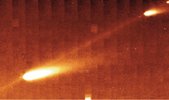The Way a Comet Crumbles
Astronomers are getting a close look at a comet that's falling apart as it nears the sun.
Share this:
- Share via email (Opens in new window) Email
- Click to share on Facebook (Opens in new window) Facebook
- Click to share on X (Opens in new window) X
- Click to share on Pinterest (Opens in new window) Pinterest
- Click to share on Reddit (Opens in new window) Reddit
- Share to Google Classroom (Opens in new window) Google Classroom
- Click to print (Opens in new window) Print
By Emily Sohn
For a comet, breaking up is not so hard to do.
A comet called 73P/Schwassmann-Wachmann 3 has been disintegrating for years, but the pace has picked up in recent weeks. The comet has already broken into at least 59 pieces. As it gets closer to the sun, scientists are expecting it to crumble even more.
 |
|
This Hubble Space Telescope image shows a large fragment, dubbed B, of Comet 73P/Schwassmann-Wachmann 3. It’s trailed by more than 30 pieces that recently broke away from the fragment.
|
| NASA, ESA, H. Weaver (APL/JHU), M. Mutchler and Z. Levay (STScI) |
Comets are giant, fragile balls of ice and dust that take odd orbits around the sun. Sometimes, they’re really far away from the sun. Sometimes, they’re really close. When a comet is near the sun, some of its ice melts, which produces its distinctive tail.
Comet 73P/Schwassmann-Wachmann 3 orbits the sun every 5.4 years. Over the past month, the Hubble Space Telescope and other instruments have watched the comet’s biggest 36 chunks break up into dozens of smaller bits. These pieces measure between 20 and 30 meters (66 to 98 feet) across.
The breakup shows that the cores of comets “are as fragile as the meringue in lemon-meringue pie,” says Casey Lisse of the Johns Hopkins Applied Physics Laboratory in Laurel, Md.
Images from the Spitzer Space Telescope show lots of tiny specks of dust between the comet chunks. One theory is that comets lose material mostly by releasing millimeter-size dust particles.
 |
|
This infrared image taken by the Spitzer Space Telescope shows dust connecting the fragments C (left) and B (upper right).
|
| Reach et al., JPL/NASA |
Analyses of some of the larger chunks reveal details about how the comet is falling apart. “The breakup has cracked the comet open like an egg,” revealing its interior composition, says Cincinnati-based Spitzer scientist Michael Sitko of the Space Science Institute.
73P/Schwassmann-Wachmann 3 will be closest to the sun on June 6. As it approaches, however, Hubble images show that some of the chunks are actually moving in the opposite direction. Heat from the sun may be the cause.
In mid-May, chunks of 73P/Schwassmann-Wachmann 3 will get within 11.7 million kilometers (7.3 million miles) of Earth. That’s the closest any comet has come to our planet in 20 years.—E. Sohn
Going Deeper:
Cowen, Ron. 2006. Big breakup: That’s the way the comet crumbles. Science News 169(May 6):277. Available at http://www.sciencenews.org/articles/20060506/fob5.asp .
You can learn more about Comet 73P/Schwassmann-Wachmann 3 at science.nasa.gov/headlines/y2006/24mar_73p.htm (NASA), hubblesite.org/newscenter/newsdesk/archive/releases/2006/18/ (Space Telescope Science Institute), and neo.jpl.nasa.gov/news/news150.html (NASA).
Ramsayer, Kate. 2006. Capturing the stuff of space. Science News for Kids (Feb. 15). Available at http://www.sciencenewsforkids.org/articles/20060215/Feature1.asp .
Sohn, Emily. 2006. Fiery dust from an icy comet. Science News for Kids (March 29). Available at http://www.sciencenewsforkids.org/articles/20060329/Note3.asp .
______. 2005. An icy blob of fluff. Science News for Kids (Sept. 14). Available at http://www.sciencenewsforkids.org/articles/20050914/Note3.asp .
______. 2005. A smashing display. Science News for Kids (Aug. 24). Available at http://www.sciencenewsforkids.org/articles/20050824/Feature1.asp .







